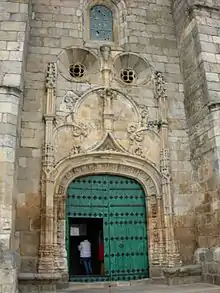Accolade (architecture)
In architecture, an accolade is an embellished arch found most typically in late Gothic architecture. The term comes from French (l'accolade), referencing a "braced" arch.[1] It is also known as an ogee arch (English), un arco conopial (Spanish), resaunt (Middle English), arco carenato or inflesso (Italian), and kielbogen (German).[1][2]

An accolade is a pointed arch composed of two ogee curves, also known as sigmoid lines, which mirror one another.[3][1] It can be formed by a pair of reverse ogee curves over a three-centered arch ending in a vertical finial.[4][5] The form can also be described as the combination of a convex arch and a concave arch.[6]
Usage
An accolade is usually a decorative molding placed over an opening.[7] The structures are unable to support significant loads, so they are primarily decorative.[6] It has been primarily used over small openings like niches, tombs, windows, and screens as it is difficult to construct.[3][7][5]
History
The accolade was introduced and was most commonly used during the Decorated period of Gothic architecture.[3] It was an element of Church architecture in England from the eleventh to sixteenth century.[8] The peak of the accolade's popularity was during the thirteenth century.[9] During the fourteenth century, there was an evolution in its appearance.[10]
The first accolades in English Gothic architecture appear on the crosses constructed by Edward I in memory of Eleanor of Castile.[11] They are also used in Gothic goldsmithing as in the shrine of St. Gertrude of Nivelles, which was originally built in the 13th century.[1] The entrance to Saint-Seine-l'Abbaye is an accolade.[12] The St. John's Church, and one of its major influences, Strawberry Hill House, incorporates accolades into its design.[13]
Accolades appear as stylistic framing elements in artwork as early as the fifteenth century.[14] It also appears in Dutch art, like the woodcut illustration in The Book of the Golden Throne.[14]
Influences
The form was likely imported to England during the Crusades.[11] There exist accolades in the Ottoman style of architecture, as at the Monastery of St. Constantine on Lake Apolyon.[15] Demus argues that the accolades, or ogee arches, at the Porta dei Fiori and the Tesoro entrance, have Islamic influences.[16] Additionally, Venetian ogee arches resemble an Iranian mihrab niche that was brought to Paris.[16] However, there is no consensus regarding how the accolade became an element of Gothic architecture.[1]
See also
References
- Binski, Paul (2017). "The Gothic Line of Beauty: Motif and Medieval Aesthetics". Quintana: Revista do Departamento de Historia da Arte (16). doi:10.15304/qui.16.5593. ISSN 2340-0005.
- Bulletin monumental, Vol. 177-3 : Après l'incendie : Notre-Dame de Paris. Paris: Société Française d'Archéologie. 2019. ISBN 978-2-901837-79-4. OCLC 1138500631.
- Parker, John Henry (1850). A Glossary of Terms Used in Grecian, Roman, Italian, and Gothic Architecture: Text. J.H. Parker.
- Sturgis, Russell (1901). A Dictionary of Architecture and Building, Volume I. Macmillan. p. 10.
- Curl, James Stevens; Wilson, Susan (2016). Oxford Dictionary of Architecture. Oxford University Press. p. 4. ISBN 978-0-19-967499-2.
- Jurco, Ancuta-Nadia & Sanda-Mariana, Bodea & George, Crisan & Scurtu, Iacob-Liviu. (2017). METHOD TO DEVELOP THE DOUBLE-CURVED SURFACE OF THE ROOF. 12.
- Harris, Cyril M. (1983-01-01). Illustrated Dictionary of Historic Architecture. Courier Corporation. ISBN 978-0-486-24444-0.
- Bond, Francis (1913). An Introduction to English Church Architecture from the Eleventh to the Sixteenth Century. H. Milford.
- Honour, Hugh. (27 August 2013). A world history of art : a History. Fleming, John, 1919-2001 (Revised seventh ed.). London. ISBN 978-1-78067-117-8. OCLC 941907107.
- Jean Mesqui. Le château de Verrès en 1390 et l’architecture seigneuriale en Val d’Aoste du XIe siècle au XVe siècle. Bulletin Monumental, Societe Francaise d'Archeologie, 2019, 177 (3), pp.219-250. ⟨halshs-02956017⟩
- Prache Anne. Jean Bony, The English Decorated Style, Gothic Architecture transformed 1250-1350. Oxford, Phaidon, 1979,92 p.. In: Bulletin Monumental, tome 139, n°2, année 1981. pp. 109-110
- "Research on the Meaning of Flamboyant Architecture - ProQuest". search.proquest.com. Retrieved 2020-12-22.
- "A 'Bastard' Building; a Child of Strawberry [Hill] uglier than its Parent: St John's Church, Deansgate". Visit Manchester. 2020-03-04. Retrieved 2020-12-23.
- K., R. A. (1958). "An Ivory Diptych from the Waning Middle Ages". Record of the Art Museum, Princeton University. 17 (2): 55–64. doi:10.2307/3774319. ISSN 0032-843X.
- Mango, Cyril (1979). "The Monastery of St. Constantine on Lake Apolyont". Dumbarton Oaks Papers. 33: 329–333. doi:10.2307/1291440. ISSN 0070-7546.
- Howard, Deborah (1991). "Venice and Islam in the Middle Ages: Some Observations on the Question of Architectural Influence". Architectural History. 34: 59–74. doi:10.2307/1568594. ISSN 0066-622X.